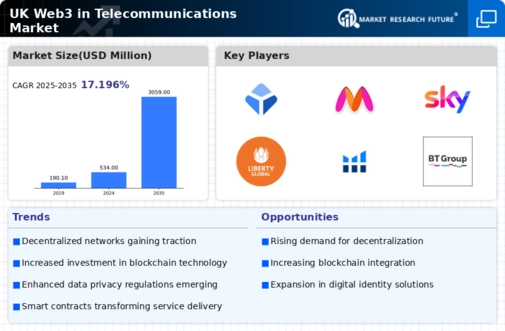Emergence of New Business Models
The web3 in-telecommunications market is witnessing the emergence of innovative business models that leverage blockchain technology. These models often focus on peer-to-peer interactions, reducing reliance on traditional intermediaries. For instance, decentralized communication platforms are gaining traction, allowing users to connect directly without centralized control. This shift could lead to cost reductions of up to 30% for consumers, as traditional service fees are minimized. Furthermore, the potential for token-based economies within these platforms may incentivize user engagement and loyalty. As these new models proliferate, they are likely to disrupt existing telecommunications paradigms, prompting established players to rethink their strategies.
Advancements in Network Infrastructure
The web3 in-telecommunications market is poised for growth due to advancements in network infrastructure. The rollout of 5G technology across the UK is expected to facilitate the integration of web3 solutions, enabling faster and more reliable connectivity. This infrastructure upgrade may support the deployment of decentralized applications that require high bandwidth and low latency. Analysts predict that the adoption of 5G could lead to a 50% increase in the efficiency of telecommunications services by 2028. As network capabilities expand, telecommunications providers may find new opportunities to innovate and offer enhanced services, further driving the growth of the web3 in-telecommunications market.
Increased Demand for Decentralized Services
The web3 in-telecommunications market is experiencing a notable surge in demand for decentralized solutions. This shift is largely driven by consumers seeking greater control over their data and privacy. As individuals become more aware of data ownership issues, the market is projected to grow at a CAGR of 25% over the next five years. This trend indicates a significant transformation in how telecommunications services are delivered, with a focus on decentralization. Companies that adapt to this demand by integrating blockchain technology into their offerings may find themselves at a competitive advantage. The emphasis on user-centric models is likely to reshape the landscape of telecommunications, fostering innovation and new business models.
Regulatory Support for Blockchain Integration
The web3 in-telecommunications market is likely to benefit from increasing regulatory support for blockchain technologies. The UK government has shown interest in fostering innovation within the telecommunications sector, particularly through the adoption of blockchain. This regulatory environment may encourage investments in decentralized applications and services. As a result, telecommunications companies could see a rise in funding opportunities, potentially exceeding £500 million by 2026. This supportive framework may facilitate the development of new solutions that enhance security and efficiency in telecommunications, thereby driving market growth. The alignment of regulatory policies with technological advancements could create a conducive atmosphere for the expansion of web3 services.
Growing Interest in Enhanced Security Solutions
The web3 in-telecommunications market is increasingly prioritizing enhanced security solutions, driven by rising concerns over data breaches and cyber threats. As telecommunications services become more integrated with digital platforms, the need for robust security measures is paramount. Blockchain technology offers unique advantages, such as immutable records and decentralized verification, which could significantly reduce vulnerabilities. The market for security solutions in telecommunications is expected to grow by 40% by 2027, reflecting the urgent need to address these challenges. Companies that invest in blockchain-based security frameworks may not only protect their infrastructure but also build trust with consumers, thereby enhancing their market position.



















Leave a Comment